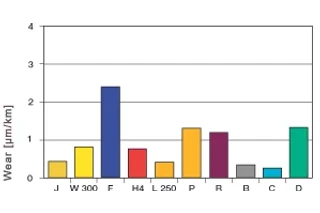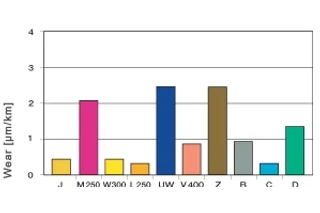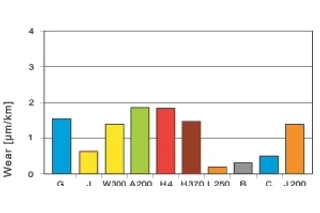Change Language :
iglide® plastic bushings - shaft materials

Figure 1.15: Wear with shaft Cf53, p = 108.75 psi, v = 98.45 fpm, Ra = 7.874 µin
Shaft materials
The shaft is, besides the bearing itself, the most important parameter in a bearing system. It is in direct contact with the bearing and is similarly affected by relative motion. However, the shaft wear is so low that it cannot be detected with traditional methods of measurement technology.
Shafts can be distinguished and classified according to their hardness and surface roughness. The effect of the surface roughness is described in the previous chapter wear resistance.
The hardness of the shaft also plays an important role. When the shafts are not as hard, the shaft is smoothed during the break-in period. Abrasive points are worn off and the surface is rebuilt. For some materials, this effect has positive influences and the wear resistance of the plastic bushing increases.

Figure 1.15: Wear with shaft Cf53, p = 108.75 psi, v = 98.45 fpm, Ra = 7.874 µin
In the following graphs, the most common shaft materials are listed and the best suited iglide® materials are compared. For easier comprehension, the scaling of the wear axis is the same in each graph.
Especially impressive are the low wear results of the systems with hard-chromed shafts. This extremely hard, yet smooth shaft acts favorably on the wear behavior with several bearing pairings. The wear of many different iglide® plastic bushing materials is lower on this shaft than on any other shafting partner tested. However, due to the typically low surface roughness, the danger of stick-slip on hard-chromed shafts is particularly high.
Such an overwhelmingly positive influence is not as readily available in the other shaft materials.
For example, with shafts made of 303 Stainless with low loads, good to excellent values can be attained with the right bearing material. However, it must also be stated that no other shaft material produces a larger variance in wear amongst the different bushing materials. For materials such as 303 Stainless Steel, therefore, the selection of the right plastic bushing is especially important.

Figure 1.17: Wear with shaft St37, p = 108.75 psi, v = 98.45 fpm, Ra = 7.874 µin
Other soft shaft materials obtain a slightly different result with different bushing materials. With machined steel, the wear values of the seven best iglide® plastic bushing materials are in a narrow range of 0.6 to 1.8. For many other shafts, the influence of the shaft materials is much larger, resulting in an up to 10 times difference between the best and the worst of the bushings tested.
If the shaft that you have chosen for your application is missing in this overview, please call us. The test results give just a sample of the existing data. All of the results were obtained under the same loads and speeds: loads p = 108.75 psi and v = 98 fpm. You can call us for other p x v combinations.





